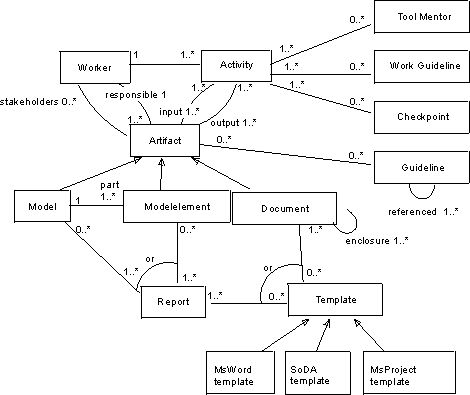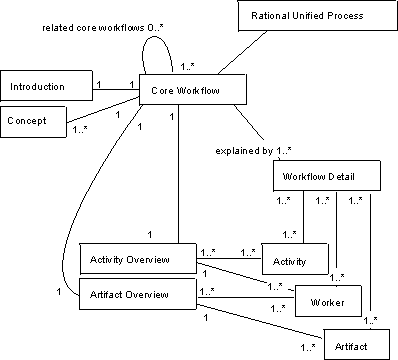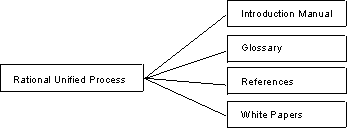Concepts: The Underlying Model of the Rational Unified Process
This is a description of the underlying model, sometimes called a meta-model, of the Rational Unified Process. For an introduction to the basic concepts of the Rational Unified Process, see the Overview.
The model is described in several diagrams to make the presentation easier to understand. There is one diagram that describes a static view of the Rational Unified Process, with the business objects, such as workers, their activities, artifacts, all related information, and their interrelationships. There is another diagram that gives a workflow view of the Rational Unified Process and describes core process workflow, workflow details, and how they are related with workers, activities, and artifacts. Finally, there is some miscellaneous information that can be viewed as attributes of the Rational Unified Process as a whole.
Topics
- Static View of the Rational Unified Process
- Workflow View of the Rational Unified Process
- Miscellaneous
Static View of the Rational Unified Process

- A worker defines the behavior and responsibilities of an individual or a set of individuals working together as a team. This is an important distinction because it's natural to think of a worker as the individual or the team itself. In the Rational Unified Process, the worker is a role that defines how the individuals should carry out the work.
- An activity is the smallest piece of relevant work. For example, it's not reasonable to do only part of an activity. Dividing the work in this manner makes it easier to monitor development. It is better, and perhaps easier, to know that the project has completed three out of five activities, rather than 60% of one activity.
- Artifacts are the modeling constructs and documents that activities evolve, maintain or use as input. An artifact can be any of the following:
- A document, such as Business Case or Software Architecture Document
- A model, such as the Use-Case Model or the Design Model
- A model element, that is, an element within a model such as a class or a subsystem.
- The review activities have checkpoints associated with them that are used when reviewing artifacts. The checkpoints are organized on a per artifact basis.
- Models and model elements have reports associated with them. A report extracts information about models and model elements from a tool. A report presents an artifact or a set of artifacts.
- There are a number of ready-to-use templates that present documents and artifacts. The Rational Unified Process provides templates to use with Microsoft« Word, SoDA, FrameMaker«, and Microsoft Project.
- Most activities in the Rational Unified Process are supported by software-engineering tools. For many activities, there are one or several tool mentors that describes how to use the tools in the Rational tool suite
- For most artifacts, the Rational Unified Process provides guidelines with detailed information about the artifact.
- The Rational Unified Process provides work guidelines with practical information about how to perform certain tasks, such as workshops and reviews. These work guidelines are referenced from activity descriptions as shown in this figure.

Workflow View of the Rational Unified
Process 
- A core workflow shows all activities you might go through to produce a particular set of artifacts. These workflows are described at an overview levelùa summary of all workers, activities, and artifacts that are involved. At a more detailed level, we show how workers collaborate to use and produce artifacts. The steps at this detailed level are called workflow details.
- Each core workflow has an introduction.
- To be able to understand a core workflow, there are certain concepts you need to understand.
- Each core workflow has an activity overview.
- Each core workflow has an artifact overview.
- The primary purpose of a workflow detail is to describe how activities are performed in reality. Normally, several activities are performed together. Workflow details are groupings of activities that are done together, presented with input and resulting artifacts. The workflow details are not necessarily performed in sequence and you may alternate between them during an iteration. Note that not all workflows have workflow details defined for them.

Miscellaneous 
There are some additional items in the Rational Unified Process.
- An Introduction Manual that introduces the Rational Unified Process and gives an overview of all concepts.
- A glossary of all terms used in the Rational Unified Process.
- References to external sources.
- White Papers that detail various topics related to the Rational Unified Process.
